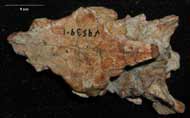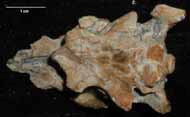Literature
Brinkman, D.B. & Peng, J.-H. (1993). New material of Sinemys (Testudines,
Sinemydidae) from the Early Cretaceous of China. Canadian Journal of Earth Sciences 30, 2139-2152.
Brinkman, D.B. & Wu, X.-C. (1999). The skull of Ordosemys, an Early Cretaceous turtle from Inner Mongolia, P. R. of China, and the interrelationships of Eucryptodira (Chelonia, Cryptodira). Paludicola, 2, 134-147.
Brinkman, D.B, Li, J.-l, & Ye, X.-K. (2008). Order Testudines. In J-L. Li, X-C. Wu, and F-C. Zhang (Eds.), The Chinese Fossil Reptiles and their Kin (pp 35-102). Science Press, Beijing.
Cope, E.D. (1868). On some Cretaceous Reptilia. Proceedings of the Academy of Natural Sciences, Philadelphia, 1868, 233-242.
Danilov, I.G. & Parham, J.F. (2006). A redescription of ‘Plesiochelys’ tatsuensis from the Late Jurassic of China, with comments on the antiquity of the crown clade Cryptodira. Journal of Vertebrate Paleontology, 26, 573–580.
Danilov, I.G. & Parham, J.F. (2008). A reassessment of some poorly known turtles from the Middle Jurassic of China, with comments on the antiquity of extant turtles. Journal of Vertebrate Paleontology, 28, 306–318.
Eberth, D.A., Brinkman, D.B., Chen, P.J., Yuan, F.T., Wu, S.Z., Li, G., & Cheng, X.S. (2001). Sequence stratigraphy, paleoclimate patterns, and vertebrate fossil preservation in Jurassic-Cretaceous strata of the Junggar Basin, Xinjiang Autonomous Region, People's Republic of China. Canadian Journal of Earth Science, 38, 1627-1644.
Evans, J. & Kemp, T.S. (1975). The cranial morphology of a new Lower Cretaceous turtle from southern England. Palaeontology, 18, 25-40.
Fang, Q.-R. (1987). A new species of Middle Jurassic turtles from Sichuan. Acta Herpetologica Sinica, 6, 65-69.
Gaffney, E.S. (1972). An illustrated glossary of turtle skull nomenclature. American Museum Novitates, 2486, 1-33.
Gaffney, E.S. (1979a). The Jurassic turtles of North America. Bulletin of the American Museum of Natural History, 162, 91-136.
Gaffney, E.S. (1979b). Comparative cranial morphology of recent and fossil turtles. Bulletin of the American Museum of Natural History, 164, 65-375.
Gaffney, E. S. & Jenkins, F. (2010). The cranial morphology of Kayentachelys, an early cryptodire, and the early history of turtles. Acta Zoologica (Stockholm), 91, 335-368.
Gaffney, E. S. & Meylan, P.A. (1992a). Sinaspideretes is not the oldest trionychid turtle. Journal of Vertebrate Paleontology, 12, 257-259.
Gaffney, E.S. & Meylan, P.A. (1992b). The Transylvanian turtle, Kallokibotion, a primitive cryptodire of Cretaceous age. American Museum Novitates, 3040, 37pp.
Gaffney, E.S., & Ye, X.-K. (1992). Dracochelys, a new cryptodiran turtle from the Early Cretaceous of China. American Museum Novitates, 3048, 13 pp.
Gaffney, E.S., Hutchison, J.H., Jenkins, F.A., & Meeker, L.J. (1987). Modern turtle origins: The oldest known cryptodire. Science, 237, 289-291.
Gaffney, E.S., Rich, T.H., Vickers-Rich, P., Constantine, A., Vacca, R., and Kool, L. (2007). Chubutemys, a new Eucryptodiran turtle from the Early Cretaceous of Argentina, and the relationships of the Meiolaniidae. American Museum Novitates, 3599, 35 pp.
Hirayama, R., Brinkman, D.B., & Danilov, I.G. (2000). Distribution and biogeography of non-marine Cretaceous turtles. Russian Journal of Herpetology, 7, 181-198.
Hutchison, J.H. (2000). Diversity of Cretaceous turtle faunas of eastern Asia and their contribution to the turtle faunas of North America. Paleontological Society of Korea Special Publication No 4, 27-38.
Kaznyshkin, M.N. (1988). Late Jurassic turtles of northern Fergana (Kirghiz SSR) (in Russian). Vestnik Zoologii, 5, 26–32.
Kaznyshkin, M.N., Nalbandyan, L.A., & Nessov , L.A. (1990). Middle and Late Jurassic turtles of Fergana (Kirghiz SSR) (in Russian). Yezhegodnik Vsesoyuznogo Paleontologicheskogo Obshchestva (Annual All-union Palaeontol Soc), 33, 185–204.
Maisch, M. W., Matzke, A.T., Pfretzschner, H.-U., Sun, G., Stöhr, H., & Grossmann, F. (2003). Fossil vertebrates from the Middle and Upper Jurassic of the southern Junggar Basin (NW China)—Results of the Sino-German Expeditions 1999-2000. Neues Jahrbuch für Geologie und Paläontologie Monatshefte 2003, 297–313.
Matzke, A.T., Maisch, M.W., Sun, G., Pfretzschner, H.-U., & Stöhr, H. (2004). A new xinjiangchelyid turtle (Testudines, Eucryptodira) from the Jurassic Qigu Formation of the southern Junggar Basin, Xinjiang, North-West China. Palaeontology, 47, 1267–1299.
Matzke, A.T., Maisch M.W., Sun, G., Pfretzschner, H.-U., & Stöhr, H. (2005). A new Middle Jurassic xinjiangchelyid turtle (Testudines; Eucryptodira) from China (Xinjiang, Junggar Basin). Journal of Vertebrate Paleontology, 25, 63–70.
Meylan, P.P., and Gaffney, E.S. 1989. The skeletal morphology of the Cretaceous cryptodiran turtle, Adocus, and the relationships of the Trionychoidea. American Museum Novitates, no. 2941, 60 pp.
Nessov, L.A. (1995). On some Mesozoic turtles of the Fergana Depression (Kyrgyzstan) and Dzhungar Alatau Ridge (Kazakhstan). Russian Journal of Herpetology, 2, 134–141.
Nopcsa, F. (1923). On the geological importance of the primitive reptilian fauna of the uppermost Cretaceous of Hungary; with a description of a new tortoise (Kallokibotion). Quarterly Journal of the Geological Society, 79, 100- 116.
Parham, J. F., and Hutchison, J. H. (2003). A new eucryptodiran turtle from the Late Cretaceous of North America (Dinosaur Provincial Park, Alberta, Canada). Journal of Vertebrate Paleontology, 23, 783-798.
Peng J.-H., & Brinkman, D.B. (1993). New material of Xinjiangchelys (Reptilia: Testudines) from the Late Jurassic Qigu Formation (Shishugou Group) of the Pingfengshan locality, Junggar Basin, Xinjiang. Canadian Journal of Earth Sciences, 30, 2013–2026.
Rabi, M. Joyce, W.G., & Wings, O. (2010). A review of the Mesozoic turtles of the Junggar Basin (Xinjiang, Northwest China) and the paleobiogeography of Jurassic to Early Cretaceous Asian testudinates. Palaeobiodiversity and Palaeoenvironments, 90, 259–273.
Rütimeyer, L. (1873). Die fossilen Schildkröten von Solothurn. Neue Denkschrift der allgemeinen schweizerischen naturforschenden Gesellschaft, 25, 1-185.
Sterli, J. and de la Fuente, M.S. (2010). Anatomy of Condorchelys antiqua Sterli, 2008 and the origin of the modern jaw closure mechanism in turtles. Journal of Vertebrate Paleontology, 30, 351-366.
Sterli, J., Müller, J., Anquetin, J., and Hilger, A. (2010). The parabasisphenoid complex in Mesozoic turtles and the evolution of the testudinate basicranium. Canadian Journal of Earth Sciences, 47, 1337-1346.
Sukhanov, V. B., and P. Narmandakh 1974. (New Early Cretaceous turtle from continental deposits of the northern Gobi). Mesozoic and Cenozoic Faunas and biostratigraphy of Mongolia. The Joint Soviet-Mongolian Paleontological Expedition. Transactions, 1, 192-200. [in Russian]
Sukhanov, V.B. (2000). Mesozoic turtles of Middle and Central Asia. In: Benton M.J., Shishkin, M.A., Unwin, D.M., & Kurochkin, E.N. (Eds.), The Age of Dinosaurs in Russia and Mongolia (pp 309–367). Cambridge: Cambridge University Press.
Sukhanov, V.B., & Narmandakh, P. (1974). (A new Early Cretaceous turtle from the continental deposits of the Northern Gobi). Mesozoic and Cenozoic Faunas and Biostratigraphy of Mongolia, The Joint Soviet-Mongolian Paleontological Expedition, Transactions, 1, 192-220. [in Russian]
Sukhanov, V.B., & Narmandakh, P. (2006). New taxa of Mesozoic turtles from Mongolia. Fossil Turtle Research, 1,119–127.
Wings O, Joyce W.G. (2009). An exceptionally large Jurassic turtle taphocoenosis from Xinjiang Autonomous province, China. Journal of Vertebrate Paleontology, 29, 3 (suppl.), 202A.
Ye, X.-K. (1963). Fossil turtles of China. Palaeontologica Sinica, 150, 1–112.
Ye, X.-K. (1973). Fossil turtles from Wu’erho (Urho) [in Chinese]. Reports of the paleontological expedition to the Xinjiang. 2. The Pterosaurian fauna from Wu’erho (Urho). Academia Sinica, Institute of Vertebrate Palaeontology and Palaeoanthropology, Memoir 11, 8–11.
Ye, H.-K. (1982). Middle Jurassic turtles from Sichuan, SW. China. Vertebrata PalAsiatica, 20, 282–290.
Ye, X.-K. (1986a). A Jurassic turtle from Junggar, Xinjiang. Vertebrata PalAsiatica, 24, 171–181.
Ye, X.-K. (1986b). New material of Plesiochelys radiplicatus with preliminary discussion of related problems. Vertebrata PalAsiatica, 24, 269–273.
Ye, X.-K. (1990). Chengyuchelyidae, n. fam., Middle Jurassic turtles of China. Studia Palaeocheloniologica, 3, 33–40.
Ye, X.-K. & Fang, Q.-R. (1982). A new species of fossil Plesiochelys from Jingyan, Sichuan. Acta Herpetologica Sinica, 1, 63–68.
Ye, X.-K. (1994). Fossil and Recent Turtles of China. Science Press, Beijing, 112 pp.
Ye, X.-K. & Pi, X. (1997). A new genus of Chengyuchelyidae from Dashanpu, Zigong Sichuan. Vertebrata PalAsiatica, 35, 182–188.
Young, C.C., Chow, M.C. (1953). New fossil reptiles from Szechuan, China. Acta Scientia Sinica, 2, 216–229.
Zhao, X.-J. (1980). Mesozoic vertebrate-bearing beds and stratigraphy of northern Xinjiang. Institute of Vertebrate Paleontology and Paleoanthropology, Memoir, 15, 1-20.




 ,
, 






